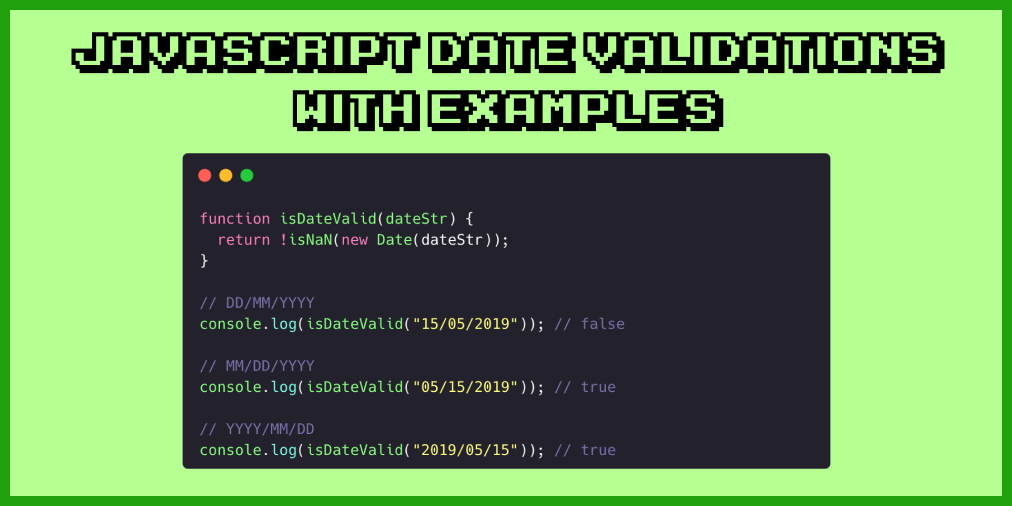There are times when you need to validate a date input in your JavaScript applications.
This article will show you how to perform the following date validations:
- Check if a string is a valid date
- Validate a string in the
DD/MM/YYYYformat - Check if the date is in the past or future
Validating a date value helps you prevent users from entering an incorrect date. Let's start with validating the input itself.
How to Check if a String is a Valid Date with JavaScript
To validate if a string is a valid date input, you need to call the Date() constructor and pass the string as its argument.
If the string is a valid date, the constructor returns a Date object holding the same value as the string:
let dateInput = "2019/05/15"; // YYYY/MM/DD format
let dateObj = new Date(dateInput);
console.log(dateObj); // 2019-05-15T00:00:00.000Z
If you pass an invalid date, the constructor returns an Invalid Date object:
let dateInput = "2019/15/15"; // YYYY/MM/DD format
let dateObj = new Date(dateInput);
console.log(dateObj); // Invalid Date
Note that the Date() constructor requires you to pass a date in the format of YYYY/MM/DD or MM/DD/YYYY. If you pass a date in DD/MM/YYYY format, the contructor also returns an Invalid Date.
Now that you have a Date object representing the string, you can use the isNaN() function to check if the object is valid.
You can create a function to check the validity of the Date object as follows:
function isDateValid(dateStr) {
return !isNaN(new Date(dateStr));
}
// DD/MM/YYYY
console.log(isDateValid("15/05/2019")); // false
// MM/DD/YYYY
console.log(isDateValid("05/15/2019")); // true
// YYYY/MM/DD
console.log(isDateValid("2019/05/15")); // true
Here, we reverse the value returned by the isNaN() function so that a valid Date returns true. You can call the isDateValid() function anytime you need to check if a string returns a valid date.
Next, let's see how to handle a date string in DD/MM/YYYY format.
How to Validate a Date and Convert it to DD/MM/YYYY Format
If you want to format the date as a DD/MM/YYYY string, you need to use a combination of getDate(), getMonth(), and getFullYear() methods to manually create the date string.
First, you validate the string in the YYYY/MM/DD format by passing it to the Date() constructor.
Next, you check if the Date value is not NaN using an if statement:
let dateInput = "2019/05/15"; // YYYY/MM/DD format
let dateObj = new Date(dateInput);
if (!isNaN(dateObj)) {
// Convert dateObj to DD/MM/YYYY
}
When the Date isn't a NaN, you can extract the date, month, and year of the object using the getDate(), getMonth(), and getFullYear() methods:
let dateInput = "2019/05/15"; // YYYY/MM/DD format
let dateObj = new Date(dateInput);
if (!isNaN(dateObj)) {
let day = dateObj.getDate();
day = day < 10 ? "0" + day : day;
let month = dateObj.getMonth() + 1;
month = month < 10 ? "0" + month : month;
const year = dateObj.getFullYear();
const resultDate = `${day}/${month}/${year}`;
console.log(resultDate); // 15/05/2019
}
Here, you can see that the date "2019/05/15" is converted into "15/05/2019". Notice how you need to modify the day and month variables to add 0 in front of the values if those values are single digits.
The getMonth() method returns a number between 0 and 11 that represents the month of the date. You need to increment the returned value by 1 to get the correct date.
What if I get the Date in DD/MM/YYYY Format?
As I said before, JavaScript doesn't support converting a string in DD/MM/YYYY format into a valid Date object.
If you have a date string in DD/MM/YYYY format, then you need to swap the date and year position before calling the Date() constructor.
You can do so by using the split() method to convert the string into an array, then swap the position of date and year at index 0 and 2.
Pass the separator / as the argument to the split method as shown below:
let dateInput = "15/05/2019"; // DD/MM/YYYY format
let dateArray = dateInput.split("/");
let newDate = `${dateArray[2]}/${dateArray[1]}/${dateArray[0]}`;
console.log(newDate); // 2019/05/15 (YYYY/MM/DD)
The newDate variable has the value of dateInput but in YYYY/MM/DD format. You can pass newDate into the Date() constructor to see if it's a valid date.
How to Check if a Date is in the Past or Future
To check if a date is in the past or future, you can use the less than < operator to compare the input date with the current date.
When the result is true, then the input date is in the past:
// The date you want to check
const inputDate = new Date('2023-08-20');
// Get the current date
const currentDate = new Date();
// Compare the input date with the current date
if (inputDate < currentDate) {
console.log('The input date is in the past.');
} else {
console.log('The input date is in the future.');
}
JavaScript knows how to compare Date objects, so you don't need to extract the values and compare them manually.
Conclusion
Now you've learned how to validate if a string is a valid date, how to convert a date into a DD/MM/YYYY format, and how to check if a date is in the past or future.
If you enjoyed this article and want to take your JavaScript skills to the next level, I recommend you check out my new book Beginning Modern JavaScript here.
The book is designed to be easy to understand and accessible to anyone looking to learn JavaScript. It provides a step-by-step gentle guide that will help you understand how to use JavaScript to create a dynamic application.
Here's my promise: You will actually feel like you understand what you're doing with JavaScript.
Until next time!


